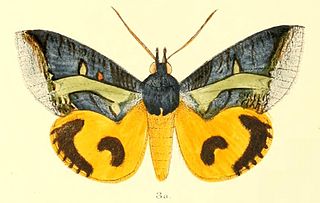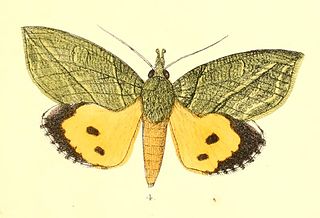
Arsacia is a monotypic moth genus of the family Noctuidae. Its only species is Arsacia rectalis. Both the genus and species were described by Francis Walker, the genus in 1866 and the species in 1863. It is found from the Indo-Australian tropics of India, Sri Lanka to Queensland and the Solomon Islands.

Dordura is a monotypic moth genus of the family Noctuidae erected by Frederic Moore in 1882. Its only species, Dordura aliena, was first described by Francis Walker in 1865. It is found in the Indian subregion, Sri Lanka, Myanmar, Thailand, Peninsular Malaysia, Sumatra, Borneo and New Guinea.

Aporandria is a monotypic moth genus in the family Geometridae described by Warren in 1894. Its single species, Aporandria specularia, was first described by Achille Guenée in 1857. It is found in Sri Lanka, India, Vietnam, Thailand, the Andamans, Peninsular Malaysia, Sumatra, Borneo, the Philippines and Sulawesi.

Eudocima materna, the dot-underwing moth, is a moth of the family Erebidae found in widespread parts of the world, mainly in tropical Asia extending to New Guinea and Australia as well as in Africa. Reports from the United States, Canada and the French Antilles are now considered to be Eudocima apta. The species can be differentiated from other Eudocima moths by the presence of small central black dot in each hindwing. The species was first described by Carl Linnaeus in his 1767 12th edition of Systema Naturae.

Thyas coronata is a species of moth of the family Erebidae first described by Johan Christian Fabricius in 1775. It is found from the Indo-Australian tropics of southern China, Taiwan, Japan, Nepal, India, Sri Lanka to Micronesia and the Society Islands.

Chalciope mygdon, the triangular-striped moth, is a moth of the family Noctuidae. The species was first described by Pieter Cramer in 1777. It is found from the Oriental region to Sundaland.
Ulotrichopus rama is a moth of the family Erebidae first described by Frederic Moore in 1885. It is found on Sumatra, Flores and Sri Lanka.

Eudocima homaena is a moth of the family Erebidae first described by Jacob Hübner in 1816. It is found in the Indian subregion, Sri Lanka, Taiwan, the Nicobars, Peninsular Malaysia, Borneo, the Philippines and on Christmas Island. It is a major pest on orange plants.

Eudocima hypermnestra is a moth of the family Erebidae described by Pieter Cramer in 1780. It is found in China, Thailand, Taiwan, India and Sri Lanka.

Chiasmia emersaria is a moth of the family Geometridae. The species was first described by Francis Walker in 1861. It is found in India, Nepal, northern Thailand, China, Sri Lanka, Japan and the Ryukyu Islands.

Eucyclodes gavissima, the Oriental orange banded green geometer moth, is a species of moth of the family Geometridae described by Francis Walker in 1861. It is found in the Indian subregion, Sri Lanka, Bhutan, western China, Taiwan, Vietnam, Sumatra and Borneo.

Urapteroides astheniata is a moth of the family Uraniidae first described by Achille Guenée in 1857. It is found in south-east Asia, from India, Sri Lanka to Fiji, including New Guinea and the tropical north of Australia.

Trachypepla euryleucota is a species of moth in the family Oecophoridae. It is endemic to New Zealand.

Mnesiloba dentifascia is a moth of the family Geometridae first described by George Hampson in 1891. It is known from the Oriental tropics.

Ischyja manlia is a species of moth of the family Noctuidae first described by Pieter Cramer in 1776. It is found in the Indian subregion, Sri Lanka, Myanmar, Thailand, China, Okinawa, Sundaland, Sulawesi, Korea, the southern Moluccas, Australia (Queensland) and Palau. Adults pierce the skin of fruit to suck the juice.
Roxita adspersella is a moth in the family Crambidae. It was described by Pieter Cornelius Tobias Snellen in 1893. It is found in Sri Lanka.

Pyrgotis plinthoglypta is a species of moth of the family Tortricidae. It is endemic to New Zealand.
Sameodes furvipicta is a moth in the family Crambidae. It is found in Papua New Guinea.
Syllepte cometa is a moth in the family Crambidae. It was described by William Warren in 1896. It is found in Assam, India.

Dichromia pullata is a moth of the family Erebidae first described by Frederic Moore in 1885. It is found in Sri Lanka and India.
















